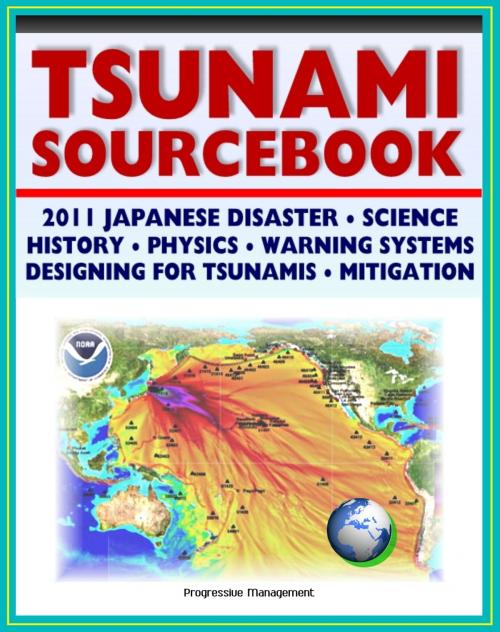2011 Tsunami Sourcebook: Japanese Disaster, Science and Survival Guides, History, Physics, Detection and Forecasting, Warning Systems, Designing for Tsunamis, Hazard Mitigation Programs
Nonfiction, Science & Nature, Science, Earth Sciences, Social & Cultural Studies, Political Science| Author: | Progressive Management | ISBN: | 9781458198242 |
| Publisher: | Progressive Management | Publication: | March 12, 2011 |
| Imprint: | Smashwords Edition | Language: | English |
| Author: | Progressive Management |
| ISBN: | 9781458198242 |
| Publisher: | Progressive Management |
| Publication: | March 12, 2011 |
| Imprint: | Smashwords Edition |
| Language: | English |
One of nature's most powerful and destructive forces is fully covered in this authoritative collection of official documents with complete details on every aspect of tsunamis - including reports on the catastrophic Honshu, Japan tsunami of March 11, 2011. Over 300 pages of coverage include: Tsunami Glossary and Background Information, Physics of Tsunamis, Historic Tsunamis, NOAA and Tsunamis, Tsunamis and Earthquakes, Making U.S. Coastal Communities Tsunami-Ready, the Tsunami Warning System, National Weather Service West Coast, Alaska, Pacific Tsunami Warning Center, Life of a Tsunami, Tsunami Vocabulary and Terminology, Tsunami Forecasting, Answers to over 100 Questions about Tsunamis, FEMA Emergency Tsunami Actions and Advice, Earthquakes and other causes, Tsunami Characteristics, Tsunami Awareness Messages, the comprehensive document Seven Principles for Planning and Designing for Tsunami Hazards, Surviving a Tsunami: Lessons from Chile, Hawaii, and Japan, the NOAA West Coast and Alaska Tsunami Warning Center Operations Manual, the National Weather Service Eastern Seaboard Tsunami Investigation Report, details about the DART tsunami monitoring buoys, threats to the western U.S. and even the eastern U.S. coastline, and much more.
A tsunami travels outward from the source region as a series of waves. Its speed depends upon the depth of the water, and consequently the waves undergo accelerations or decelerations in passing respectively over an ocean bottom of increasing or decreasing depth. By this process the direction of wave propagation also changes, and the wave energy can become focused or defocused. In the deep ocean, tsunami waves can travel at speeds of 500 to 1,000 kilometers (km) per hour. Near the shore, however, a tsunami slows down to just a few tens of kilometers per hour. The height of a tsunami also depends upon the water depth. A tsunami that is just a meter in height in the deep ocean can grow to tens of meters at the shoreline. Unlike familiar wind-driven ocean waves that are only a disturbance of the sea surface, the tsunami wave energy extends to the ocean bottom. Near the shore, this energy is concentrated in the vertical direction by the reduction in water depth, and in the horizontal direction by a shortening of the wavelength due to the wave slowing down. The 03/11/2011 earthquake (preliminary magnitude 8.9) near the east coast of Honshu, Japan, occurred as a result of thrust faulting on or near the subduction zone interface plate boundary between the Pacific and North America plates. At the latitude of this earthquake, the Pacific plate moves approximately westwards with respect to the North America plate at a velocity of 83 mm/yr. The Pacific plate thrusts underneath Japan at the Japan Trench, and dips to the west beneath Eurasia. The location, depth, and focal mechanism of the March 11 earthquake are consistent with the event having occurred as thrust faulting associated with subduction along this plate boundary. Note that some authors divide this region into several microplates that together define the relative motions between the larger Pacific, North America and Eurasia plates; these include the Okhotsk and Amur microplates that are respectively part of North America and Eurasia.
This is a privately authored news service and educational publication of Progressive Management.
One of nature's most powerful and destructive forces is fully covered in this authoritative collection of official documents with complete details on every aspect of tsunamis - including reports on the catastrophic Honshu, Japan tsunami of March 11, 2011. Over 300 pages of coverage include: Tsunami Glossary and Background Information, Physics of Tsunamis, Historic Tsunamis, NOAA and Tsunamis, Tsunamis and Earthquakes, Making U.S. Coastal Communities Tsunami-Ready, the Tsunami Warning System, National Weather Service West Coast, Alaska, Pacific Tsunami Warning Center, Life of a Tsunami, Tsunami Vocabulary and Terminology, Tsunami Forecasting, Answers to over 100 Questions about Tsunamis, FEMA Emergency Tsunami Actions and Advice, Earthquakes and other causes, Tsunami Characteristics, Tsunami Awareness Messages, the comprehensive document Seven Principles for Planning and Designing for Tsunami Hazards, Surviving a Tsunami: Lessons from Chile, Hawaii, and Japan, the NOAA West Coast and Alaska Tsunami Warning Center Operations Manual, the National Weather Service Eastern Seaboard Tsunami Investigation Report, details about the DART tsunami monitoring buoys, threats to the western U.S. and even the eastern U.S. coastline, and much more.
A tsunami travels outward from the source region as a series of waves. Its speed depends upon the depth of the water, and consequently the waves undergo accelerations or decelerations in passing respectively over an ocean bottom of increasing or decreasing depth. By this process the direction of wave propagation also changes, and the wave energy can become focused or defocused. In the deep ocean, tsunami waves can travel at speeds of 500 to 1,000 kilometers (km) per hour. Near the shore, however, a tsunami slows down to just a few tens of kilometers per hour. The height of a tsunami also depends upon the water depth. A tsunami that is just a meter in height in the deep ocean can grow to tens of meters at the shoreline. Unlike familiar wind-driven ocean waves that are only a disturbance of the sea surface, the tsunami wave energy extends to the ocean bottom. Near the shore, this energy is concentrated in the vertical direction by the reduction in water depth, and in the horizontal direction by a shortening of the wavelength due to the wave slowing down. The 03/11/2011 earthquake (preliminary magnitude 8.9) near the east coast of Honshu, Japan, occurred as a result of thrust faulting on or near the subduction zone interface plate boundary between the Pacific and North America plates. At the latitude of this earthquake, the Pacific plate moves approximately westwards with respect to the North America plate at a velocity of 83 mm/yr. The Pacific plate thrusts underneath Japan at the Japan Trench, and dips to the west beneath Eurasia. The location, depth, and focal mechanism of the March 11 earthquake are consistent with the event having occurred as thrust faulting associated with subduction along this plate boundary. Note that some authors divide this region into several microplates that together define the relative motions between the larger Pacific, North America and Eurasia plates; these include the Okhotsk and Amur microplates that are respectively part of North America and Eurasia.
This is a privately authored news service and educational publication of Progressive Management.















